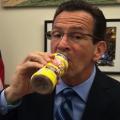New REAL® Seal Video Contrasts Dairy Nutrition versus the Imitators
July 02, 2014Just in time for summer, the REAL® Seal debuted a beach-motif YouTube video contrasting the nutrition in real dairy products versus with imitations made from vegetables and nuts. DairyUS, the animated version of the REAL® Seal logo, reminds viewers that, unlike the imitators, real dairy products are packed with vitamins, minerals and protein.
“Look for the REAL® Seal if you want the real deal,” he advises. In July, the REAL® Seal Facebook page is leveraging National Ice Cream Month and asking food bloggers to create recipes around the theme “We all scream for ice cream!”
CWT-Assisted Dairy Export Sales Top 18.7 Million Pounds in June
July 02, 2014Cooperatives Working Together helped member cooperatives sell 18.7 million pounds of dairy products overseas in June. The voluntary, farmer-funded program will provide assistance on 48 overseas sales from seven different cooperatives: Dairy Farmers of America, Maryland & Virginia Milk Producers Association, Michigan Milk Producers Association, Northwest Dairy Association (Darigold), Tillamook County Creamery Association and Upstate-O-AT-KA. The products included 10.8 million pounds of American-type cheese, 4.1 million pounds of butter, and 3.8 million pounds of whole milk powder. All will be delivered before the end of the year.
June sales bring the year-to-date total to more than 120 million pounds of dairy product export sales assisted by CWT, the equivalent of 1.753 billion pounds of milk on a milkfat basis.
Ways & Means Chair Highlights NMPF Concern on GIs, Trade Barriers
July 02, 2014 In separate mid-June comments, the chairmen of both the House Ways and Means Committee and its trade subcommittee expressed strong opposition to European Union efforts to use geographical indications to restrict the use of generic food names. They also underscored the importance of securing favorable outcomes for the Trans Pacific Partnership negotiations, particularly with Japan on agricultural issues.
In separate mid-June comments, the chairmen of both the House Ways and Means Committee and its trade subcommittee expressed strong opposition to European Union efforts to use geographical indications to restrict the use of generic food names. They also underscored the importance of securing favorable outcomes for the Trans Pacific Partnership negotiations, particularly with Japan on agricultural issues.
Both Ways and Means Chairman Dave Camp (R-MI, pictured above) and Trade Subcommittee Chairman Devin Nunes (R-CA) said U.S.-EU negotiations on the Transatlantic Trade and Investment Partnership are important opportunities but only if progress is made on eliminating barriers to agriculture exports.
Camp, speaking to the Global Business Dialogue, an international business group focused on trade, said the EU must follow through on pledges to eliminate its agriculture tariffs and address food safety barriers not based on science. In addition, he said, “We must also end the EU’s improper use of GIs to block U.S. exports to Europe and third countries.”
Nunes, opening a hearing on expanding U.S. farm trade, said he was “particularly concerned” about improper European use of GIs to restrict on the use of generic food names. “This threatens the U.S. dairy industry and cannot be tolerated,” he added.
TTIP negotiations are scheduled to resume this month in Brussels, where NPPF staff will meet with EU representatives on both geographical indications and other dairy issues.
On separate negotiations over the Pacific trade agreement, also resuming this month, both Camp and Nunes stressed the importance of securing access to Japan’s agricultural market.
NMPF Chairman Randy Mooney discussed increased access to both the Japanese and Canadian dairy markets with New Zealand Trade Minister Timothy Groser during Groser’s visit to Washington in June. Like NMPF, New Zealand favors opening the Japanese dairy market through the Trans Pacific Partnership. Early in June more than three dozen U.S. dairy companies, all members of NMPF or the U.S. Dairy Export Council, threatened to withdraw support from TPP if Japan and Canada refuse to follow through on pledges to provide comprehensive market access for U.S. dairy products.
CCFN to EU: ‘Do the Right Thing’ on Havarti Designation
July 02, 2014 The Consortium for Common Food Names, which NMPF supports, is urging the European Union to make the right decision on a controversial proposal granting Denmark exclusive use of the generic cheese name “havarti” in the EU. CCFN filed comments objecting to the proposal as part of the EU’s review of “geographical indications,” or names associated with specialized foods from a particular region.
The Consortium for Common Food Names, which NMPF supports, is urging the European Union to make the right decision on a controversial proposal granting Denmark exclusive use of the generic cheese name “havarti” in the EU. CCFN filed comments objecting to the proposal as part of the EU’s review of “geographical indications,” or names associated with specialized foods from a particular region.
“We expect the European Commission to do the right thing, and respect the common name havarti, which is used around the world,” said Jaime Castaneda, CCFN executive director. Castaneda noted that not only is havarti widely used in non-European countries, but there is an international havarti product standard that is recognized by Europe and others.
“There are ways to protect the names of geographical specialty foods and beverages without impeding the rights to use generic food names,” he said. “If the EU ultimately registers this GI, it would be one of the most egregious examples of Europe’s GI policy gone wrong.”
In recent years the EU has moved past the concept of protected geographical names such as “Parmigiano Reggiano” to seek exclusive use of the common term related to the name, such as “parmesan” or simply to claim ownership of a common name, as in “feta.”
The Consortium for Common Food Names is an independent non-profit favoring high GI standards and the adoption of worldwide model geographical indication guidelines.
NMPF Asks FDA to Leave Dairy Farms Out of New Bioterrorism Regs
July 02, 2014Arguing that milk leaving U.S. dairy farms is an unlikely target for a terrorist attack, NMPF asked the Food and Drug Administration to exempt dairy producers from “intentional adulteration” regulations being issued under the major rewrite of federal food safety laws enacted in 2011.
In comments filed with FDA on June 30, NMPF said it’s hard to predict where milk from any one dairy farm will go because of constantly changing processing needs around the country. As a result, NMPF said, milk leaving a dairy farm is unlikely to be a target for intentional adulteration and “activities on dairy farmers should not be addressed through this rule.”
NMPF also pointed out that dairy farms already employ a number of general security strategies that further reduce risks to plant-bound milk and that many anti-terrorist procedures are already being used on these farms.
In addition, NMPF submitted comments jointly with the International Dairy Foods Association questioning FDA’s proposed regulations focused on preventing intentional adulteration at dairy processing plants. Like dairy farms, the two organizations said, processing facilities have taken an active approach to applying food defense concepts.
In all, FDA has proposed seven major regulations under the Food Safety Modernization Act signed into law in January 2011. Only this rule addresses terrorism, while the others have less direct impact on dairy farms. NMPF will be submitting comments at the end of this month on a major proposed FSMA regulation addressing sanitary transport.
Common Sense Prevails in Connecticut School Milk Debate
July 02, 2014 The latest skirmish in the battle over chocolate milk in schools ended June 12 when Connecticut Governor Dannel Malloy (left, drinking milk) vetoed legislation that would have effectively banned chocolate milk from state schools. The bill, passed on the final day of the legislature’s 2014 session, would have prohibited the sale of chocolate milk by setting a tight limit on the sodium allowed in drinks offered in Connecticut schools.
The latest skirmish in the battle over chocolate milk in schools ended June 12 when Connecticut Governor Dannel Malloy (left, drinking milk) vetoed legislation that would have effectively banned chocolate milk from state schools. The bill, passed on the final day of the legislature’s 2014 session, would have prohibited the sale of chocolate milk by setting a tight limit on the sodium allowed in drinks offered in Connecticut schools.
“I love chocolate milk, I love chocolate shakes, I like chocolate,” said Malloy. “I’m also a big milk person so looking at this … this was the right decision to make.”
“It’s encouraging to see reason and common sense returning to the debate over chocolate milk in schools,” NMPF President and CEO Jim Mulhern said in a statement.
“Schools that remove chocolate milk from the cafeteria are simply throwing the nutritional baby out with the bathwater. They deprive kids of calcium, protein and other needed nutrients while they increase waste and boost costs. Governor Malloy is to be congratulated for thinking this through, and not opting for the quick, easy but wrong solution.” NMPF had urged Malloy to veto the bill.
NMPF Makes Implementation Recommendations to USDA on New Dairy Safety Net
July 02, 2014 NMPF has made a series of recommendations to the Agriculture Department on how to implement the new dairy safety net included in the 2014 farm bill. The recommendations cover issues that are either unclear in the legislation or were left up to USDA to decide. The issues include such things as the timing of enrollment, the timing and structure of premium payments, and the treatment of farms with changing ownership structures.
NMPF has made a series of recommendations to the Agriculture Department on how to implement the new dairy safety net included in the 2014 farm bill. The recommendations cover issues that are either unclear in the legislation or were left up to USDA to decide. The issues include such things as the timing of enrollment, the timing and structure of premium payments, and the treatment of farms with changing ownership structures.
The new safety net, called the Margin Protection Program (MPP), is required to be established by September 1. It replaces price supports, MILC payments and other, less effective federal programs. It will help protect against the type of catastrophic equity loss that many dairy farmers experienced in 2009 and again in 2012. NMPF is pleased with its discussions with the Agriculture Department on MPP to date.
In order to help dairy farmers understand the new Margin Protection Program, NMPF is providing a set of data examining how the MPP margin has varied over time, dating back to 2007, up until the current month for which data is available.
This set of tables listing feed and milk prices is available below to download in Excel as well as PDF. It will be updated by NMPF every two months going forward, using the same calculations that the USDA is expected to use as the program is implemented later in 2014.
Apparent Demise of Immigration Legislation in Congress Frustrating for Farmers, Consumers
July 02, 2014 NMPF President and CEO Jim Mulhern reacted sharply to the apparent demise of immigration reform legislation in Congress this year. But Mulhern added that NMPF remains committed to the cause of reform, which, he said, will happen eventually.
NMPF President and CEO Jim Mulhern reacted sharply to the apparent demise of immigration reform legislation in Congress this year. But Mulhern added that NMPF remains committed to the cause of reform, which, he said, will happen eventually.
“It is very frustrating for America’s dairy farmers that our elected officials could not set aside partisan politics this year to finally address the dysfunctional policy of our immigration system,” Mulhern said in a statement. “The irony is that virtually everyone on both ends of Pennsylvania Avenue admits the status quo is unacceptable; yet we seem destined to continue suffering from it, because common-sense reforms remain beyond our reach.”
In addition to the headaches the immigration dilemma causes dairy farmers, Mulhern said, the lack of an immigration fix is bad news for America’s consumers, who depend on a domestic food production system that itself is dependent on immigrant workers.
“The reality is that most major public policy controversies take multiple efforts, by a variety of stakeholders working together in common cause, to finally make things happen,” Mulhern added. “Immigration reform will happen. It is only a matter of time. We remain committed to that effort.”
EPA Grants More Time to Consider Controversial ‘Waters of the U.S.’ Regulation
July 02, 2014Ten days after NMPF requested it, the Environmental Protection Agency agreed to allow more time to examine its controversial draft regulation expanding the waterways subject to pollution controls under the federal Clean Water Act. The new deadline for submitting public comments is October 10.
NMPF cited two reasons for requesting more time: First, the EPA and the Army Corps of Engineers had not completed the report providing the scientific underpinning for the regulation; and second, many of the key concepts discussed in the draft are unclear or subject to interpretation by government regulators.
“Dairy farmers are committed to protecting U.S. waters both voluntarily and under the Clean Water Act,” said NMPF President and CEO Jim Mulhern, “but the EPA needs to go about this effort in the right way. Allowing more time to consider EPA’s draft will give everyone the chance to adequately consider the issues raised in the draft and provide an opportunity for a more informed process.”
Unveiled in March, the draft regulation expands the waterways covered under the 1972 Clean Water Act to nearly all those connected to U.S. navigable waters. Concerns have been raised by many farm organizations that the proposed rule could have a devastating impact, particularly on agriculture.
“Given the scope and complexities of the proposed rule and its supporting documents, it was essential that EPA allow more time to consider the issues it raises,” Mulhern said.





